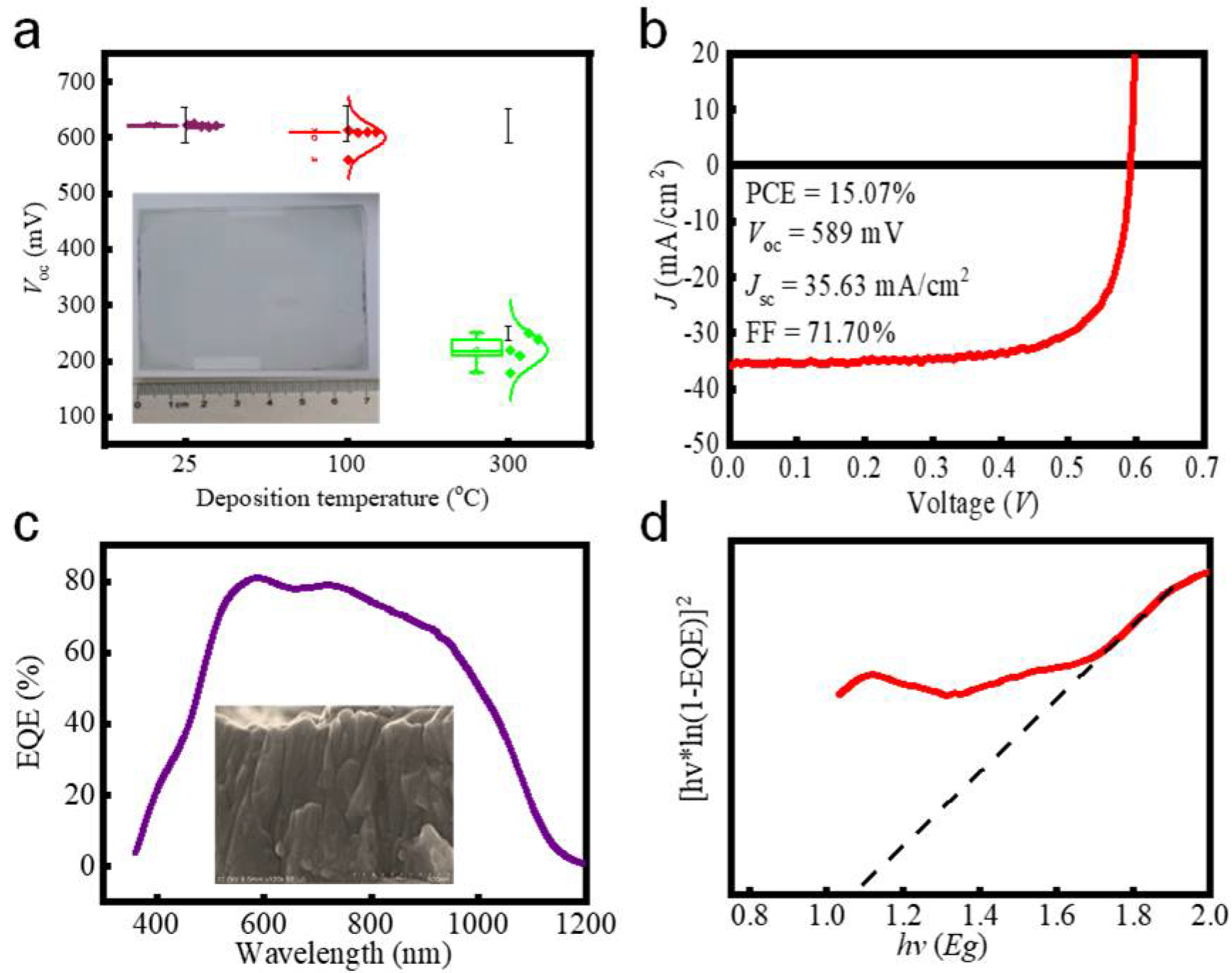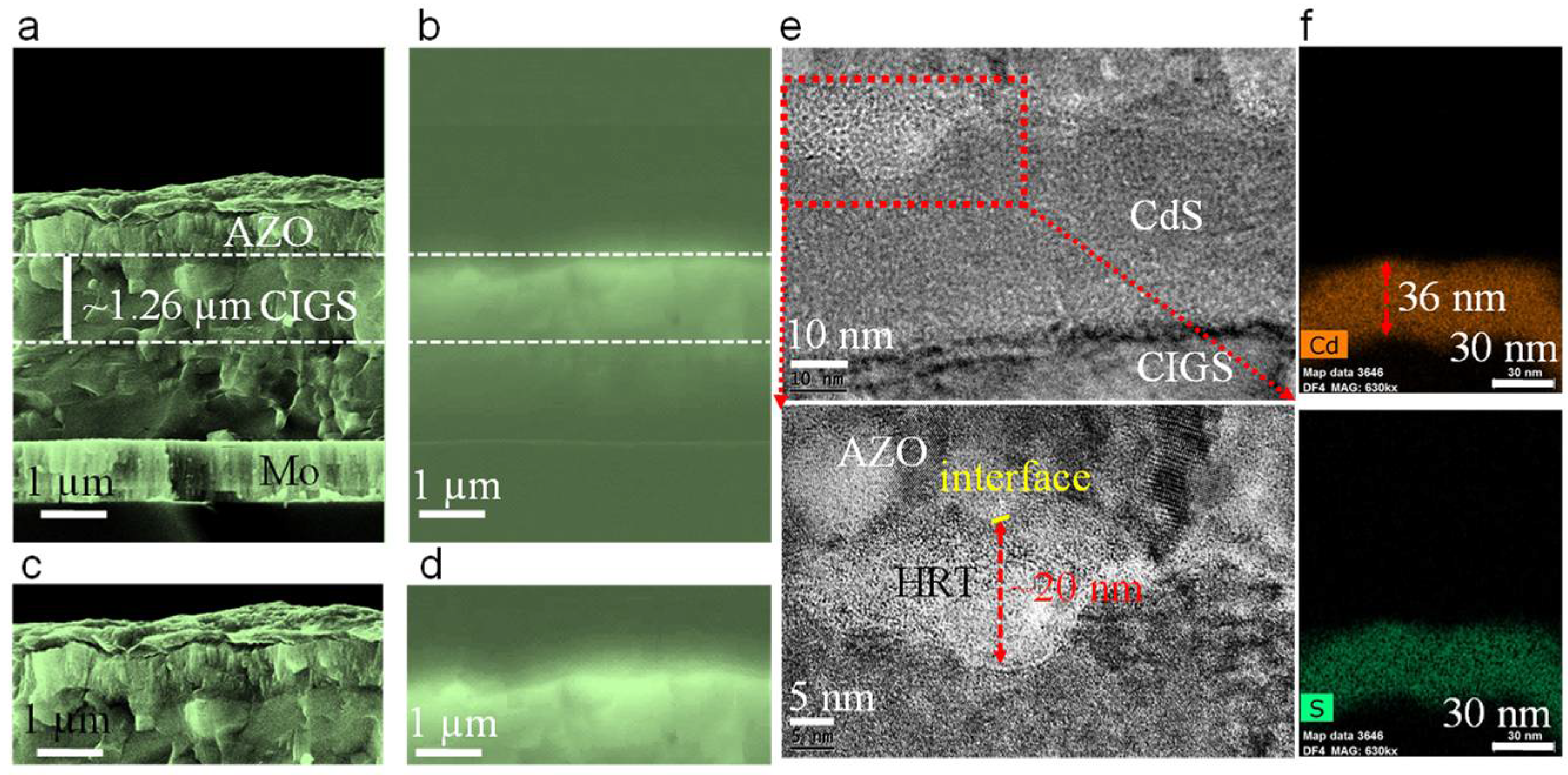Front Transparent Passivation of CIGS-Based Solar Cells via AZO
Abstract
:1. Introduction
2. Experiments and Characterizations
3. Results
4. Conclusions
Supplementary Materials
Author Contributions
Funding
Institutional Review Board Statement
Informed Consent Statement
Data Availability Statement
Conflicts of Interest
Sample Availability
References
- Li, H.; Zhang, W. Perovskite tandem solar cells: From fundamentals to commercial deployment. Chem. Rev. 2020, 120, 9835. [Google Scholar] [CrossRef] [PubMed]
- Bouich, A. Study and Characterization of Hybrid Perovskites and Copper-Indium-Gallium Selenide thin films for Tandem Solar Cells. Ph.D. Thesis, Universitat Politècnica de València, Valencia, Spain, 2020. [Google Scholar] [CrossRef]
- Islam, M.M.; Ishizuka, S.; Yamada, A.; Sakurai, K.; Niki, S.; Sakurai, T.; Akimoto, K. CIGS solar cell with MBE-grown ZnS buffer layer. Sol. Energy Mater. Sol. Cells 2009, 93, 970. [Google Scholar] [CrossRef]
- Kaelin, M.; Rudmann, D.; Tiwari, A.N. Low cost processing of CIGS thin film solar cells. Sol. Energy 2004, 77, 749. [Google Scholar] [CrossRef]
- Julia, M.G.; Amal, B.; Bernabé, M. Shedding Light on Phase Stability and Surface Engineering of Formamidinium Lead Iodide (FAPbI3) Thin Films for Solar Cells. Eng. Proc. 2021, 12, 2001. [Google Scholar] [CrossRef]
- Zhao, Y.H.; Yuan, S.J.; Chang, Q.Q.; Zhou, Z.J.; Kou, D.X.; Zhou, W.H.; Qi, Y.F.; Wu, S.X. Controllable formation of ordered vacancy compound for high efficiency solution processed Cu(In,Ga)Se2 solar cells. Adv. Funct. Mater. 2021, 31, 2007928. [Google Scholar] [CrossRef]
- Arthur, O.; Carey, R.; Siming, L.; Adam, D.; William, W.; Alexandra, B.; Sachit, G.; Jeff, B.; Gang, X.; Darius, K.; et al. Understanding what limits the voltage of polycrystalline CdSeTe solar cells. Nat. Energy 2022, 7, 400. [Google Scholar] [CrossRef]
- Li, H.; Chen, J.W.; Qu, F.; Zhang, Y.; Wang, W.J.; Gu, H.W. Efficiency enhancement of CIGS solar cells via recombination passivation. ACS Appl. Energy Mater. 2020, 3, 9459. [Google Scholar] [CrossRef]
- Gouillart, L.; Cattoni, A.; Chen, W.C.; Goffard, J.; Riekehr, L.; Keller, J.; Jubault, M.; Naghavi, N.; Edoff, M.; Collin, S. Interface engineering of ultrathin Cu(In,Ga)Se2 solar cells on reflective back contacts. Prog. Photovolt. Res. Appl. 2021, 29, 212. [Google Scholar] [CrossRef]
- Ramanujam, J.; Singh, U.P. Copper indium gallium selenide based solar cells—A review. Energy Environ. Sci. 2017, 10, 1306. [Google Scholar] [CrossRef]
- Shi, W.Q.; Theelen, M.; Gevaerts, V.; Illiberi, A.; Barreau, N.; Butterling, M.; Schut, H.; Egger, W.; Dickmann, M.; Hugenschmidt, C.; et al. Positron annihilation studies on the damp heat degradation of ZnO:Al transparent conductive oxide Layers for CIGS solar cells. IEEE J. Photovolt. 2018, 8, 1847. [Google Scholar] [CrossRef]
- Cho, D.H.; Lee, K.S.; Chung, Y.D.; Kim, J.H.; Park, S.J.; Kim, J. Electronic effect of Na on Cu(In,Ga)Se2 solar cells. J. Appl. Phys. Lett. 2012, 101, 023901. [Google Scholar] [CrossRef]
- Park, J.H.; Lee, S.; Song, E.; Shin, S.; Kang, C.; Yoon, H.; Lee, S.; Yang, J.; Lee, D.; Kim, D.; et al. Homogeneous Na incorporation for industrial-scale application of Cu(In,Ga)(Se,S)2 solar cells. Prog. Photovolt. Res. Appl. 2018, 26, 112. [Google Scholar] [CrossRef]
- Ahrum, J.; Jae Myung, C.; Hyun-Jae, L.; Gee Yeong, K.; Jong-Keuk, P.; Won Mok, K.; Seungkuk, K.; Zhen, W.; David, J.H.; Hyeonggeun, Y.; et al. Transparent back-junction control in Cu(In,Ga)Se2 absorber for high-efficiency, color-neutral, and semitransparent solar module. Prog. Photovolt. Res. Appl. 2022, 30, 713. [Google Scholar] [CrossRef]
- Jeong, S.H.; Boo, J.H. Influence of target-to-substrate distance on the properties of AZO films grown by RF magnetron sputtering. Thin Solid Films 2004, 447–448, 105–110. [Google Scholar] [CrossRef]
- Shi, Q.; Zhou, K.; Dai, M.; Hou, H.; Lin, S.; Wei, C.; Hu, F. Room temperature preparation of high performance AZO films by MF sputtering. Ceram. Int. 2013, 39, 1135–1141. [Google Scholar] [CrossRef]
- Sarma, B.; Barman, D.; Sarma, B.K. AZO (Al:ZnO) thin films with high figure of merit as stable indium free transparent conducting oxide. Appl. Surf. Sci. 2019, 479, 786–795. [Google Scholar] [CrossRef]
- Cho, H.J.; Lee, S.U.; Hong, B.; Shin, Y.D.; Ju, J.Y.; Kim, H.D.; Park, M.; Choi, W.S. The effect of annealing on Al-doped ZnO films deposited by RF magnetron sputtering method for transparent electrodes. Thin Solid Films 2010, 518, 2941–2944. [Google Scholar] [CrossRef]
- Xia, Y.; Wang, P.; Shi, S.; Zhang, M.; He, G.; Lv, J.; Sun, Z. Deposition and characterization of AZO thin films on flexible glass substrates using DC magnetron sputtering technique. Ceram. Int. 2017, 43, 4536–4544. [Google Scholar] [CrossRef]
- Kim, T.W.; Choo, D.C.; No, Y.S.; Choi, W.K.; Choi, E.H. High work function of Al-doped zinc-oxide thin films as transparent conductive anodes in organic light-emitting devices. Appl. Surf. Sci. 2006, 253, 1917–1920. [Google Scholar] [CrossRef]
- Liu, W.S.; Hsieh, W.T.; Chen, S.Y.; Huang, C.S. Improvement of CIGS solar cells with high performance transparent conducting Ti-doped GaZnO thin films. Sol. Energy 2018, 174, 83. [Google Scholar] [CrossRef]
- Nagle, T.; Bailey Ieee, J. Determination of AZO hall parameters on flexible CIGS solar cells. In Proceedings of the IEEE 43rd Photovoltaic Specialists Conference (PVSC 2016), Portland, OR, USA, 5–10 June 2016; p. 2242. [Google Scholar]
- Khawla, F.; Amal, B.; Bechir, S.; Radhouane, C. Towards improving the optoelectronics properties of MAPbI3(1− x)B3x/ZnO heterojunction by bromine doping. Optik 2022, 249, 168283. [Google Scholar] [CrossRef]
- Ćwil, M.; Igalson, M.; Zabierowski, P.; Kaufmann, C.A.; Neisser, A. Capacitance profiling in the CIGS solar cells. Thin Solid Film 2007, 515, 6229. [Google Scholar] [CrossRef]
- Lin, X.L.; Li, H.; Qu, F.; Gu, H.W.; Wang, W.J. Cu(In,Ga)Se2 solar cell with Zn(S,O) as the buffer layer fabricated by a chemical bath deposition method. Sol. Energy 2018, 171, 130. [Google Scholar] [CrossRef]
- Yu, H.J.; Lee, W.J.; Wi, J.H.; Cho, D.H.; Han, W.S.; Chung, Y.D.; Kim, T.S.; Song, J.H. Light-soaking effects and capacitance profiling in Cu(In, Ga)Se2 thin-film solar cells with chemical-bath-deposited ZnS buffer layers. Phys. Chem. Chem. Phys. 2016, 18, 33211. [Google Scholar] [CrossRef]
- Ballutaud, D.; Rivière, A.; Rusu, M.; Bourdais, S.; Slaoui, A. EBIC technique applied to polycrystalline silicon thin films: Minority carrier diffusion length improvement by hydrogenation. Thin Solid Films 2022, 403–404, 549. [Google Scholar] [CrossRef]
- Malte, K.; Manuel, P.; Paul, P.; Rudi, S.; Alexandr, Z.; Bart, M.; Andreas, L.; Weiyuan, D.; Pengfei, C.; Benjamin, K.; et al. A silicon carbide-based highly transparent passivating contact for crystalline silicon solar cells approaching efficiencies of 24%. Nat. Energy 2021, 6, 529. [Google Scholar] [CrossRef]
- Academic, E.; Bouchta, S.; Baizeng, F. Manufacture of high-efficiency and stable lead-free solar cells through antisolvent quenching engineering. Nanomaterials 2022, 12, 2901. [Google Scholar] [CrossRef]





| Frequency (kHz) | Doping Concentration (1015 cm−3) | Depletion Layer Width (nm) |
|---|---|---|
| 300 | 9.37 | 1154 |
| 400 | 5.45 | 1268 |
| 400 (−1 V) | 6.33 | 1271 |
| 400 (1 V) | 2.63 | 1297 |
Publisher’s Note: MDPI stays neutral with regard to jurisdictional claims in published maps and institutional affiliations. |
© 2022 by the authors. Licensee MDPI, Basel, Switzerland. This article is an open access article distributed under the terms and conditions of the Creative Commons Attribution (CC BY) license (https://creativecommons.org/licenses/by/4.0/).
Share and Cite
Zhang, H.; Qu, F.; Li, H. Front Transparent Passivation of CIGS-Based Solar Cells via AZO. Molecules 2022, 27, 6285. https://doi.org/10.3390/molecules27196285
Zhang H, Qu F, Li H. Front Transparent Passivation of CIGS-Based Solar Cells via AZO. Molecules. 2022; 27(19):6285. https://doi.org/10.3390/molecules27196285
Chicago/Turabian StyleZhang, He, Fei Qu, and Hui Li. 2022. "Front Transparent Passivation of CIGS-Based Solar Cells via AZO" Molecules 27, no. 19: 6285. https://doi.org/10.3390/molecules27196285
APA StyleZhang, H., Qu, F., & Li, H. (2022). Front Transparent Passivation of CIGS-Based Solar Cells via AZO. Molecules, 27(19), 6285. https://doi.org/10.3390/molecules27196285





